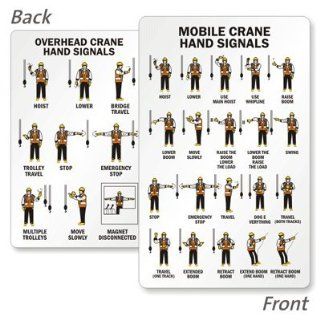

"Anyone who takes on the role of a qualified signal person should be aware of certain responsibilities that go along with the job," noted a Certified Slings blog post.Ī qualified signal person is needed not just during standard crane work, but anytime a crane operator does not have a clear range of vision or may feel that their lift area is compromised.īut, added the Casselberry, Fla., company, "just to be on the safe side, crane operators often go above and beyond by requesting a qualified signal person for situations that might not even seem threatening." He or she has the ability to communicate messages faster than speech. Why Qualification Makes SenseĪ qualified signal person understands the concepts of speed, clarity, noise and distance working around a crane, said Zajicek.Ī qualified signal person knows that relying on hand signals significantly reduces the chances of miscommunication.
#Crane signals full
"A signal person is required when the point of operation is not in full view of the operator, or the crane operator's view is obstructed in the direction of where the equipment or load is traveling," according to the Crane Inspection & Certification Bureau (CICB). In his or her safety capacity, the signaler must ensure people remain outside the crane area and must never instruct loads be swung directly over people. He or she should have a commanding voice. The signaler must understand the crane's operations and limitations including the dynamics involved in raising, swinging, boom deflection, stopping and lowering loads.Īnd, the signal person must always have a clear view of the crane operator and the work site as a whole. The signaler must demonstrate his or her knowledge through oral, written or practical tests. "If modifications are made to any signals, they must be agreed upon by the crane operator, lift director and signal person, and cannot conflict with the standard signals," she added.īefore working on the project, the signal person must undergo evaluation by a qualified in-house or third-party evaluator. "These individuals must know all signals for mobile, tower and overhead cranes and have a basic understanding of crane operation," she said.Ĭharts identifying these hand signals must be posted on equipment or noticeably near hoisting operations. "When working as a signal person in a facility or at a job site, especially those with lots of traffic, it is crucial to understand and use crane operator hand signals," Lagowski noted in outlining the requirements of a qualified signal person. He or she must be competent in using hand signals. OSHA expects a signaler to know and understand each type of signal used at a job site. "The crane operator can only follow one signaler at a time and has to obey given signals under every circumstance," according to Zajicek. If the lift requires two signalers who swap duties, the person in charge must have a clear form of identification. Only one signaler can take charge at any moment. The signal person is required to be trained and qualified to serve in this role. She believes "it's the supervisors' duty to implement every possible measure that boosts safety and productivity." Qualified to Make the Call Hand signals are instantaneous and highly effective in noisy environments, said Christie Lagowski, communications manager of Columbus McKinnon, Getzville, N.Y. They're often used for signal calling, though systems can malfunction. Radio systems are regularly used between the crane operator and ground crew, including the signaler, to communicate. The importance of a signal person is heightened during critical lifts where the crane operator's view is obstructed and loads are moved solely based on signals, added Zajicek.

#Crane signals code
"Crane operators are expected to move loads by adhering to an established code of signals while using the help of a qualified and trained signal person." "Correct signaling and communication are crucial for preventing crane accidents from taking place," she wrote in a blog post for the company, which provides sales, service and support for Rayco Wylie crane indicators. "Signal persons are essentially the eyes and ears of crane operators and have a vital role to play in guiding operations," said Carmen Zajicek of Crane Warning Systems, Atlanta, Ga. The relationship between crane operator and signal person is key to a successful lift. The qualified signaler prevents accidents, ensures solid lift and placement of the load and keeps everyone safe on the ground.

The signal person is one of the most critical roles on a construction site where a crane is in operation.


 0 kommentar(er)
0 kommentar(er)
